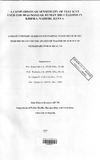| dc.description.abstract | Animal and human health is inextricably linked. People depend on animals for nutrition,
socio-economic development and companionship. Yet animals can transmit many
different diseases to humans.
Brucellosis is a common zoonosis in Kenya. In areas where the disease occurs,
malaria, and typhoid which manifest with similar clinical symptoms also occur.
Therefore clinical diagnosis of brucellosis needs confirmation. This requires a test with
high specificity and sensitivity. This study was therefore carried out with the objectives
of
Increasing the precision in the diagnosis of human brucellosis.
Specific objectives were:
1) Determining the sero-prevalence of human brucellosis among patients with clinical
signs consistent with brucellosis attending health clinic / hospital in kibera.
2) To determine the prevalence of Typhoid and Malaria as differential diagnoses for
brucellosis in the above patients.
3) To compare the sensitivity of rapid kits used in the diagnosis of human brucellosis
in Kenya with Rose Bengal Plate Test and Competitive Elisa.
4) To compare Agreement between Rose Bengal Plate test and Competitive Elisa
In Kenya, diseases with flu-like symptoms such as brucellosis, malaria typhoid and
paratyphoid pose a diagnostic problem to clinicians as the diseases can occur
concurrently in the same patient or in the same locality. A study was carried out by the
University of Nairobi in conjunction with the African Medical and Research Foundation
(AMREF) at the AMREF Kibera Community Clinic and Mbagathi District Hospital to
determine the occurrence of brucellosis in patients presenting with febrile conditions in a
slum setting in Kibera, Kenya.
Patients presenting with clinical symptoms and signs consistent with brucellosis were
selected for the study. Blood samples were collected aseptically. A portion was used to
make blood films for examining for malaria parasites and blood culturing for Salmonella
spp. From the other portion of blood serum was extracted and used for diagnosis of
brucellosis using competitive Elisa test, Rose Bengal plate test and four other serological
test kits from Biotec laboratories, Fortress Diagnostics limited, Tulip diagnostics and
Eurocell diagnostics which are used in local hospitals for the diagnosis of brucellosis.
A total of 105 Patients were recruited into the study. Samples collected were tested for
brucellosis using on-site rapid test kits at the health facilities. One sample was positive
on the Rose Bengal test and five samples were positive for brucellosis on all the other
agglutination tests. Two blood cultures were positive for Salmonella typhi and one blood
sample was positive for malaria parasites. The agglutination kits showed different
positive results depending on the Kit used. No sample was positive for brucellosis using
Competitive Elisa Test.
The results from this study indicate no prevalence of brucellosis in patients 111 the
population studied based on ELISA. However, the agglutination tests to detect Brucella
antibodies did not agree with ELISA test which was used as the gold standard for testing
brucellosis in this study, thus giving false positive results, and therefore there is a need to
re-evaluate the diagnostic tests for brucellosis before their use in health facilities. | en |

